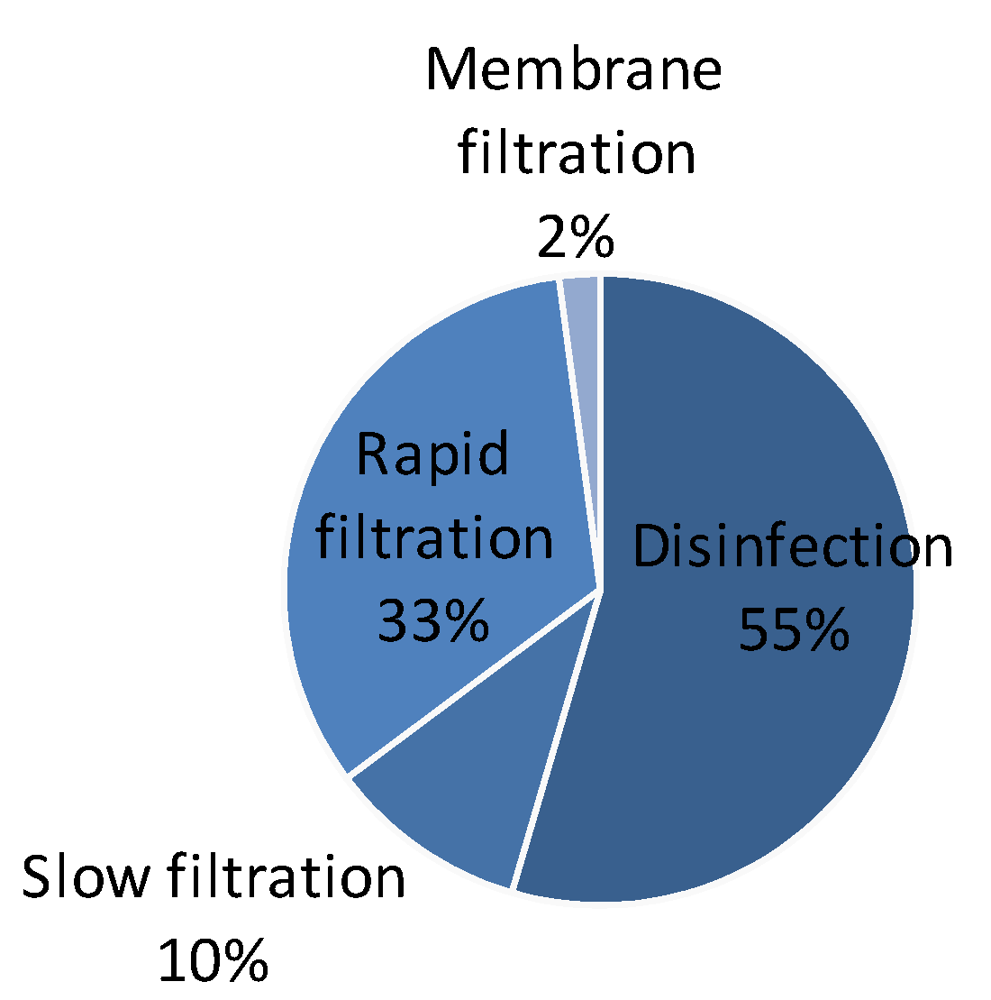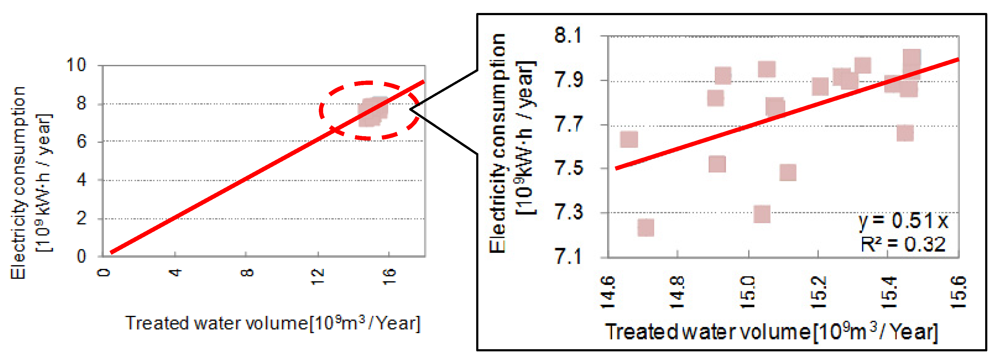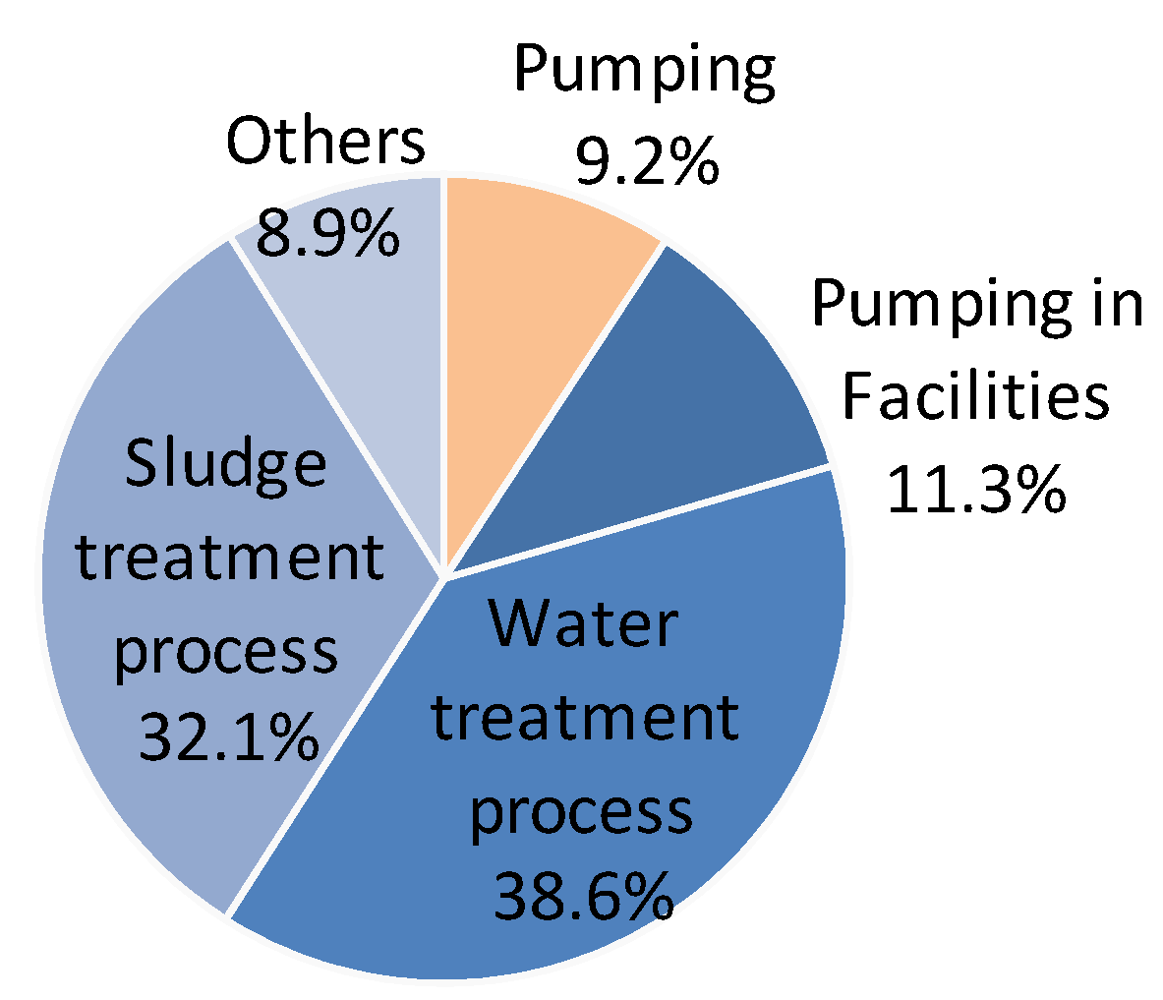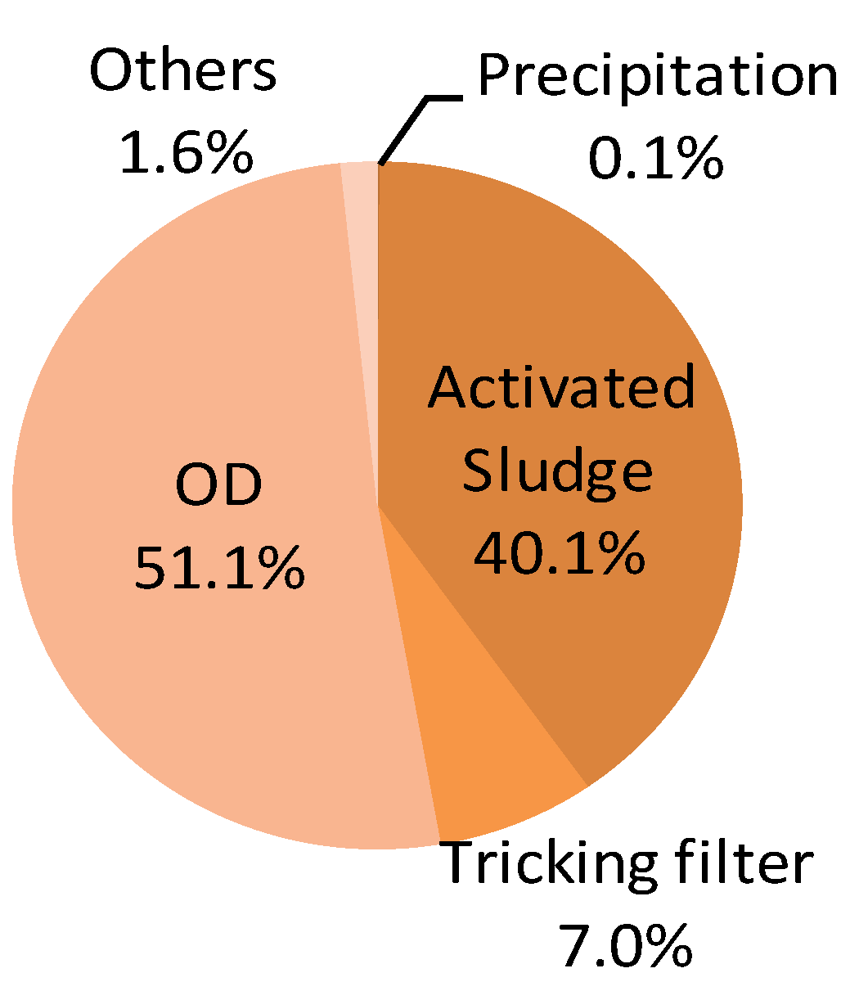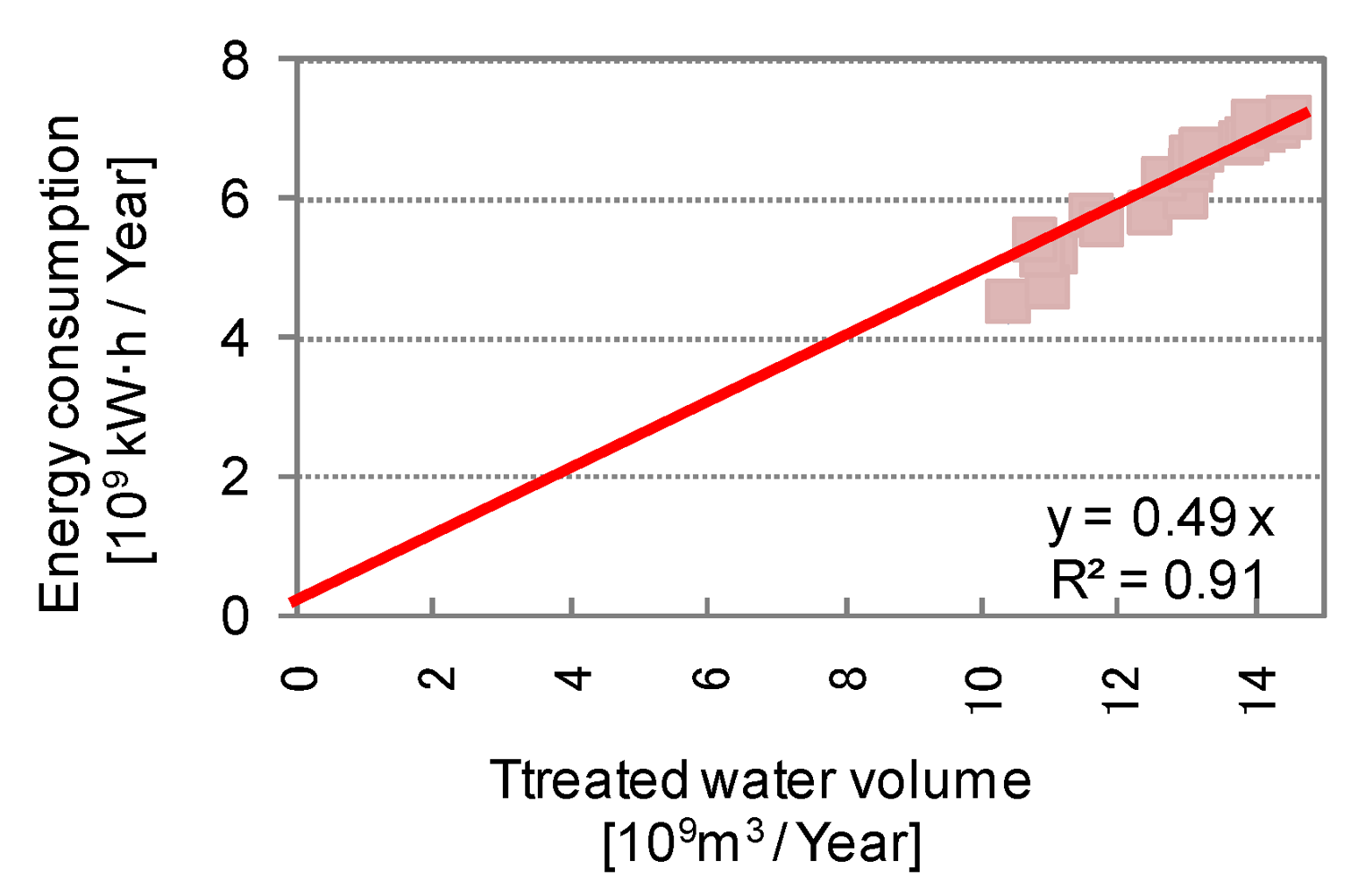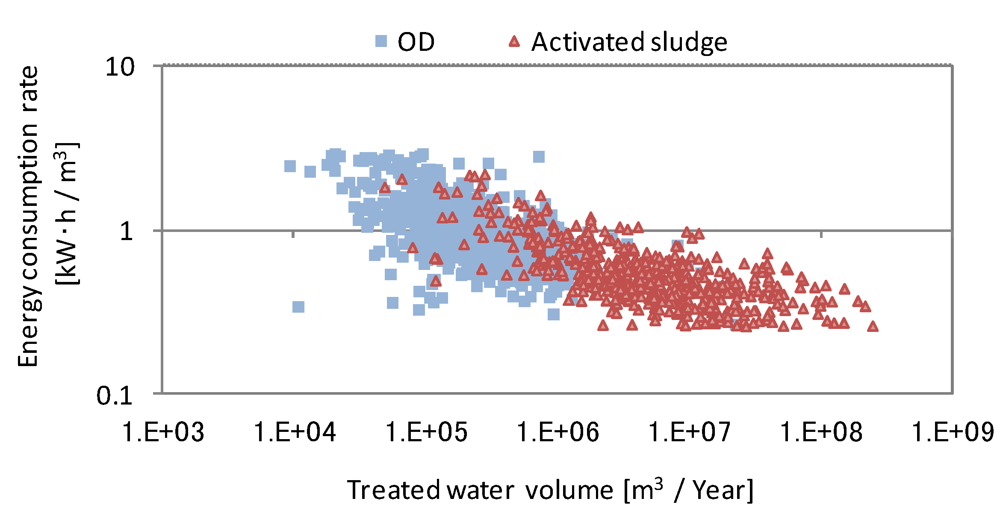3.1. Waterworks System
The rate of increase in water supply coverage in Japan shows a monotonous increase by 2.8% from 94.7% in 1990 to 97.5% in 2008; its population increased by 3.4% from 123.53 million to 127.78 million in 2006, but stopped increasing thereafter. In spite of the factors that may cause an increase in water consumption, the amount of water supply (effective water volume) increased from 14.7 billion m
3/year in 1990 to quickly peak at 15.5 billion m
3/year in 1998, and thereafter. It has shown a decreasing trend owing to the widespread use of water-saving systems,
etc. These changes in water supply are shown in
Figure 3 along with the changes in the overall energy consumption of the entire waterworks systems in Japan.
Figure 3.
Generated fresh water volumes and electricity consumptions for all water works in Japan.
Figure 3.
Generated fresh water volumes and electricity consumptions for all water works in Japan.
We analyzed these values to check whether the amount of fresh water generated and energy consumption were proportional. For energy consumption of whole waterworks, systems mainly consist of electricity (energy consumption ratio of electricity and fuel was 95:5). Fuel was thought to be used for drying and incineration of the sludge produced from water purification processes. Since the sludge treatment occurred with every purification method, the electricity and fuel use ratios in each processing method were regarded as the same. In addition, fuel consumption data of each facility was not reported. Therefore, analysis of the energy of the waterworks system in this research was only conducted as concerns electricity.
The breakdown of electricity consumption during the process is shown in
Figure 4;
Figure 5 shows the breakdown of the adopted water treatment processes by facility; and the breakdown of electricity consumption rate by facility and by treatment facility scale (treated water volume) is shown in
Figure 6. Contrary to the expectation that the electricity consumption rate for treatment would vary dramatically among different water treatment methods, ranging from disinfection only to membrane filtration, we could not find any correlation between the electricity consumption rate of the facility and the treatment method, treated water volume,
etc. in the same fiscal year data.
Figure 4.
Breakdown of energy consumption for waterworks in Japan.
Figure 4.
Breakdown of energy consumption for waterworks in Japan.
Figure 5.
Adoption ratio of treatment processes for waterworks in Japan.
Figure 5.
Adoption ratio of treatment processes for waterworks in Japan.
Figure 6.
Relationship between energy consumption rates and treated water volumes of waterworks facilities in Japan.
Figure 6.
Relationship between energy consumption rates and treated water volumes of waterworks facilities in Japan.
This was because of the fact that the overall electricity consumption at each facility was dominated by pumping and feeding processes, as described as intake, transmission delivery and distribution in
Figure 4, as 81%, and that the electricity consumption of these pumping and feeding processes varied with the facility characteristics, such as water distribution. We thus studied the relationship between the average treatment consumption rate for all facilities in a fiscal year and the water treatment volume in order to compare the consumption rates for identical facility characteristics. The results are presented in
Figure 7.
The results show that the water volume and the electricity consumption of the system are proportional to each other. As the pumping energy, which is attributed to 81% of the electricity consumption of the waterworks system, is proportional to the volume of water, by analogy the electricity consumed in the water purification processes can be considered to be proportional to the volume of water; thus, it is possible to determine a CO
2 emission factor for water in waterworks systems on the basis of the volume of water. The CO
2 emission factors for water are shown in
Figure 8. For calculation, the emission factor of electricity was adopted as the average value for all power sources in Japan at the generating end and fuel consumption was taken into consideration.
Figure 7.
Relationship between electricity consumption and treated water volume for waterworks.
Figure 7.
Relationship between electricity consumption and treated water volume for waterworks.
Figure 8.
CO2 emission factor of water in Japan incorporating the generating end electricity factor.
Figure 8.
CO2 emission factor of water in Japan incorporating the generating end electricity factor.
3.2. Sewer System
In the sewer system, fuel consumption occupied a bigger ratio than a waterworks, at 10%. The electricity and fuel consumption data for all facilities was released by the Sewerage Statistics. The energy consumption, which added electricity and fuel together, was then studied for the sewer system.
The breakdown of energy consumption of the sewer systems and that for the treatment processes adopted by the facility is shown in
Figure 9 and
Figure 10, respectively. The processes can be largely classified into water feeding process, conversion of biochemical oxygen demand (BOD) into sludge and water purification, and the concentration and disposal of the converted sludge. Although the energy consumption during the water feeding process, which contributes to 21% of the total energy consumption, is assumed to be proportional to the volume of water, we expected that the energy consumption during purification and sludge treatment would depend on both the amount of BOD (pollution load) and the volume of water.
Figure 9.
Energy consumption ratio of sewer systems in Japan.
Figure 9.
Energy consumption ratio of sewer systems in Japan.
Figure 10.
Adoption ratio of treatment processes in sewer systems in Japan.
Figure 10.
Adoption ratio of treatment processes in sewer systems in Japan.
Since the amount of pollution load generated by households does not change even when water saving measures are adopted for residential systems, we used the operation data to analyze the factors that may affect energy consumption of the sewerage treatment systems when water-saving measures are popularized. The changes in the volume of water treated and in energy consumption of the sewer systems in Japan are presented in
Figure 11. Owing to the increase in the coverage of the sewerage system, the water treatment volume increased by 40% since 1990. The relationship between energy consumption and water treatment volume, as observed from the data shown in
Figure 11, is plotted in
Figure 12. While energy consumption was proportional to the volume of water for all systems, the total pollution load also increased in proportion to the volume of water. We therefore analyzed this in detail.
We analyzed the effect of the treated water volume of the facilities on the energy consumption rate based on the data from FY 2008. The results are presented in
Figure 13; the energy consumption rate clearly varies depending on the treated water volume in sewer systems. To homogenize the effects of the treated water volume, we extracted data on facilities with treatment capacities of 100 to 500 km
3/year and studied the relationship between the influent BOD concentration and energy consumption. While the influent BOD concentration into sewerage treatment facilities varied from about 90 to 380 kg/m
3 depending on the facility, there was no correlation between the influent BOD concentration and energy consumption.
Figure 11.
Treated wastewater volumes and electricity consumptions for all sewer systems in Japan.
Figure 11.
Treated wastewater volumes and electricity consumptions for all sewer systems in Japan.
Figure 12.
Relationship between energy consumption and treated wastewater volume for sewer systems.
Figure 12.
Relationship between energy consumption and treated wastewater volume for sewer systems.
Figure 13.
Relationship between energy consumption rates and treated wastewater volumes for sewer systems in Japan.
Figure 13.
Relationship between energy consumption rates and treated wastewater volumes for sewer systems in Japan.
We found that energy consumption converged to a certain value (
Figure 14). Thus, we concluded that the energy consumption of each facility can be considered to depend largely on the volume of water treated and that there is little effect of the changes in influent BOD concentration on the energy consumption.
On the basis of the above results, we surmised that the energy consumption of sewer systems is also proportional to the volume of water in the range of volume changes that can be expected to result from the adoption of water-saving measures,
etc. in the future. The changes in the CO
2 emission factor for the sewer systems are shown in
Figure 8. For this calculation, electricity and fuel consumption was taken into consideration.
The changes in influent sewage volume and BOD concentration fluctuate dramatically with time. On the other hand, the volume of processed water released from the system is controlled so that the effluent regulations including a BOD of less than 20 kg/m3 are ensured. Thus, the sewer systems can be considered highly stable against external disturbances in water volume, pollution load, etc. Although we assume that the effects of an increase in pollution load resulting from water-saving measures are not noticeable because of the highly stable nature of the system, we await the results of future studies to identify the detailed mechanism explaining the stability of the system to changes in pollution load.
Figure 14.
Relationship between energy consumptions and influent BOD concentrations for sewerage treatment facilities.
Figure 14.
Relationship between energy consumptions and influent BOD concentrations for sewerage treatment facilities.
3.3. CO2 Emission Factor for Water
We found that energy consumption was proportional to the volume of water treated in both waterworks and sewer systems; the latest CO
2 emission factors for water are shown in
Table 1. For the calculation, the emission factor of electricity was adopted as the average value for all power sources in Japan at the both receiving and generating ends by assuming its application in CDM and Bilateral Offset Credit Mechanism. The calculated energy consumption rate value was about the same value as foreign countries values, such as Taiwan of 0.78 kWh/m
3 [
13], UK of 0.98 kWh/m
3 [
14] and China of 1.37 kWh/m
3 [
15]. Detailed analysis will be conducted by future research.
Table 1.
Energy consumption rate and CO2 emission factor of water in Japan (FY 2008, kg CO2/m3).
Table 1.
Energy consumption rate and CO2 emission factor of water in Japan (FY 2008, kg CO2/m3).
| Treatment process | Energy consumption rate (kWh/m3) | CO2 emission factor of water (kg CO2/m3) |
|---|
| Calculated with generating end electricity (0.335 kg CO2/kW∙h) | Calculated with receiving end electricity (0.373 kg CO2/kW∙h) |
|---|
| Waterworks system | 0.499 | 0.181 | 0.201 |
| Sewer system | 0.512 | 0.195 | 0.214 |
| Total | 1.012 | 0.376 | 0.415 |
In the future, it will be possible to update the CO2 emission factor for water using Equation (1) and the latest values from Waterworks Statistics, Sewerage Statistics, and CO2 emission factor for electricity, which are updated annually.
where CFw is CO2 emission factor for water (kg CO2/m3); CFe is CO2 emission factor for electricity (kg CO2/kWh); Ewi is energy consumption by waterworks system (kW·h/year); Esi is energy consumption by sewer system (kW∙h/year); Qwi is volume of fresh water generation by waterworks (m3/year); Qsi is volume of water treated by sewer system (m3/year).
In structures such as apartment buildings and office buildings, water supplied from the waterworks is first accumulated in water tanks and then distributed to each residential unit or equipment by using pumps. Since the energy consumption for pumping in buildings could not be standardized, it is not included in the range of calculation in this study. Further study along these lines will be necessary in the future.




